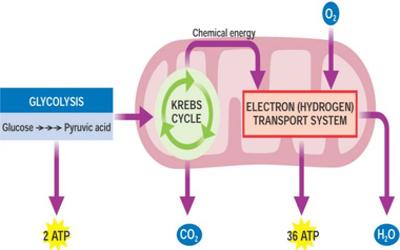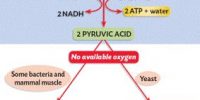Aerobic Respiration is the normal respiration of plant and animals. In this process, Carbohydrates break down and produce CO2 water and energy. Usually, aerobic respiration is completed in four steps. the steps are as follows:
Step – 1: Glycolysis: In this step one molecule of glucose, a 6-Carbon compound, after 9 successive reactions produce two molecules of Pyruvic, Acid, a 3- Carbon compound. In this step, 4 molecules of ATP (2 molecules utilised) and 2 molecules of NADPH2 are produced.
Step – 2: Formation of Acetyl CO-A: Each molecule of Pyruvic Acid produce during glycolysis after four successive reactions produce, one molecule of Acetyle Co-A, a 2-Carbon compound, one molecule of CO2 and one molecule of NADH2. [From 2 molecules of pyruvic acid there produces 2 molecules of Acetyl CO-A, 2 molecules of CO2 and 2 molecules of NADH2]

Step – 3: Krebs Cycle: Every molecule of Acetyl Co-A enter Krebs Cycle and after 10 successive reactions produce 2 molecules of COT, 3 molecules of FADH2, and I molecule of GTP (=ATP). From two molecules of Acetyl CO-A there produces 4 molecules of CO2, 6 molecules of NADH2, 2 molecules of FADH2, and 2 molecules of GTP (=ATP).
Step – 4: Electron Transport System: NADH2 and FADH2 produced in the first step, being oxidized produce ATP and water.
In aerobic respiration, the complete oxidation of one molecule glucose totally produces 6 molecules of water and 38 ATP (686 K. Cal. Energy). First two steps occur in the cytoplasm and next two steps occur in mitochondria. Every reaction of respiration is completed with the help of special types of Enzymes.














